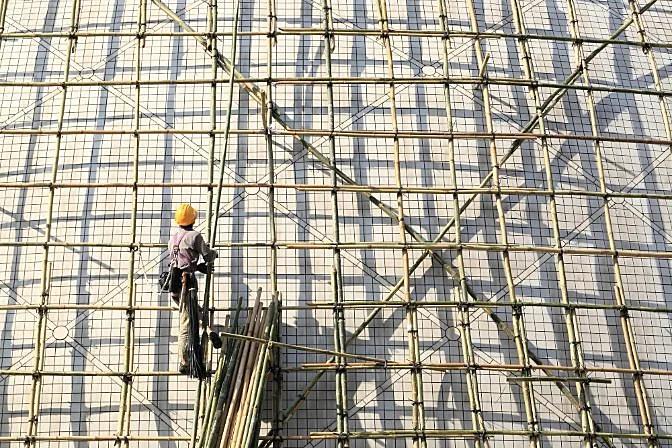Professional Scaffolder Surrey: Your Trusted Partner for Safe Installations
Professional Scaffolder Surrey: Your Trusted Partner for Safe Installations
Blog Article
Discovering the Various Sorts Of Scaffolding Made Use Of in Building Projects
The building sector relies greatly on various kinds of scaffolding to satisfy details job demands, each offering distinctive benefits and applications. Standard frame scaffolding provides a strong structure for general jobs, while put on hold scaffolding is crucial for work on high-rise frameworks.

Traditional Framework Scaffolding
Standard structure scaffolding is among one of the most commonly used methods in the construction industry because of its robustness and versatility. This system is composed of straight and vertical frameworks that are constructed to develop a stable system for workers and products. The main parts consist of upright posts, straight ledgers, and diagonal dental braces, which together provide a solid framework that can sustain considerable loads.
Among the vital advantages of conventional framework scaffolding is its versatility to various building and construction projects, ranging from residential structures to huge industrial frameworks. The modular design allows for very easy assembly and disassembly, making it efficient for both lasting and temporary projects. Furthermore, the system can be tailored in elevation and width, fitting various structure designs and site problems.
Security is extremely important in scaffolding applications, and traditional frame systems are outfitted with guardrails and toe boards to protect against falls and make certain employee security. Regular evaluations and adherence to safety and security laws are vital in preserving the honesty of the scaffold (Scaffolding). Generally, traditional framework scaffolding stays a fundamental choice in the building industry, supplying a trusted platform for labor and boosting total job performance

Suspended Scaffolding
Suspended scaffolding provides a special option for construction tasks that call for access to raised surface areas, specifically in circumstances where standard frame scaffolding may be not practical. This kind of scaffolding is generally suspended from the roof or top levels of a structure, making use of a system of pulley-blocks, systems, and ropes to develop a functioning room that can be gotten used to various heights.
Among the primary advantages of put on hold scaffolding is its flexibility. It can be quickly rearranged or lowered to suit adjustments in building needs, making it excellent for jobs such as window setup, façade job, and maintenance on skyscraper structures. Additionally, the marginal footprint of suspended scaffolding permits better use ground space in city settings, where area is usually restricted.
Security is an important consideration in the use of put on hold scaffolding. In general, suspended scaffolding offers a efficient and reliable service for accessing hard-to-reach areas in numerous building and construction scenarios, boosting both productivity and safety on site.
System Scaffolding
System scaffolding, often considered as a contemporary service in the scaffolding industry, consists of pre-engineered parts that can be quickly constructed and adapted for numerous building and construction tasks. Scaffolding. This kind of scaffolding is identified by its modular layout, which enables flexibility and effectiveness on work sites, suiting architectural requirements and various elevations
Commonly made from high-strength steel or light weight aluminum, system scaffolding provides boosted longevity and stability. The parts consist of upright messages, horizontal ledgers, and angled dental braces, which interconnect securely, making certain a robust framework. The style usually integrates standard installations, simplifying setting up and disassembly processes, thus decreasing labor time and costs.

Rolling Scaffolding
Moving scaffolding is a versatile alternative to standard fixed scaffolding, created for wheelchair and convenience of usage on construction sites. This kind of scaffolding contains a system sustained by structures with wheels, allowing workers to quickly relocate it as required. The flexibility feature dramatically boosts efficiency, as it lessens downtime related to taking apart and constructing dealt with scaffolding.
Commonly created from light-weight products such as aluminum or steel, rolling scaffolding supplies a tough yet mobile solution for projects calling for constant repositioning - Scaffolding. It is particularly helpful in tasks such as paint, drywall installment, and electrical job, where accessibility to different elevations and locations is necessary
Safety is vital in rolling scaffolding style, with attributes such as securing wheels to prevent unexpected movement when in usage, and guardrails to safeguard employees from falls. Furthermore, many designs are adjustable in height, accommodating different project needs.
Cantilever Scaffolding

The layout of cantilever scaffolding typically entails utilizing arms or brackets anchored to a structure or framework, enabling the system to expand exterior securely. Security is paramount; therefore, these scaffolds must be crafted to hold up against ecological conditions and numerous loads. Normal assessment and upkeep click here to find out more are important to guarantee architectural honesty and employee safety.
Cantilever scaffolding is favored for its adaptability and efficient use of room, making it a preferred option in city settings where room restrictions are typical. Furthermore, it facilitates much easier access to high altitudes, eventually adding to the general efficiency of building and construction jobs. As with all scaffolding kinds, proper training and adherence to safety and security criteria are crucial for workers making use of cantilever scaffolding.
Conclusion
In verdict, the varied types of scaffolding utilized in building jobs each serve distinct functions tailored to details website requirements. Typical structure scaffolding gives security, while put on hold scaffolding provides convenience for elevated tasks. System scaffolding helps with quick assembly, and rolling scaffolding boosts flexibility for differing workplace. Cantilever scaffolding effectively deals with obstacles in urban setups. Understanding these scaffolding types is crucial for enhancing security and YOURURL.com performance in building, inevitably adding to the effective conclusion of jobs.
Standard structure scaffolding gives a strong structure for basic jobs, while put on hold scaffolding is vital for job on skyscraper structures.Rolling scaffolding is a functional alternative to conventional fixed scaffolding, designed for mobility and ease of use on construction websites. As with all scaffolding kinds, appropriate training and adherence to safety requirements are essential for workers using cantilever scaffolding.
Standard framework scaffolding gives security, while suspended scaffolding uses versatility for elevated tasks. System scaffolding assists in quick assembly, and rolling scaffolding improves flexibility for varying job atmospheres.
Report this page